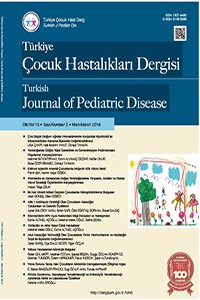Öz
TORTİKOLLİS VE ALTTA YATAN CİDDİ
HASTALIKLAR
Giriş: Tortikollis,
boynun rotasyonel deformitesine bağlı başın bir yana eğilmesi ile karakterize
bir klinik bulgudur. Konjenital olarak meydana gelebileceği gibi birçok altta
yatan basit veya ciddi hastalık tortikollise neden olabilir. Bu çalışmadaki
amaçlarımız, tortikollis tanısı almış hastaların konjenital ve edinsel
dağılımlarını ortaya çıkartmak ve özellikle edinsel tortikollis saptanan
hastalarda altta yatan nedenleri belirleyip olayın ciddiyeti ile ilgili uyarıcı
semptomları saptamaktır.
Gereç ve Yöntemler:
Ocak 2011-Kasım 2018 tarihleri arasında hastanemiz genel pediatri
polikliniklerine başvuran ve tortikollis tanısı alan çocuk hastaların hastane
kayıtları incelendi. Hastaların demografik verileri, başvuru
semptomları, fizik inceleme bulguları, laboratuvar ve radyolojik verileri
kaydedildi.
Bulgular:
Tortikollis nedeni ile başvuran toplam 532 hasta vardı. Bu hastaların %44,3’ü
(n=232) edinsel tortikollis grubunda idi. En sık edinsel tortikollis nedenleri enfeksiyonlar
(%29,3) ve postural tortikollis (%13,2) idi. Dokuz hastada ise daha nadir
nedenlere bağlı tortikollis geliştiği görüldü. Bu nadir nedenler sırası ile
Grisel sendromu (n=5), şaşılık (n=2), Sandifer sendromu (sitrülinemiye bağlı)
(n=1) ve lösemi (n=1) idi. Kusma (OR:23,1[13,6-42,1]), ateş (OR:5,1 [2,6-7,8])
ve yutma güçlüğü (OR: 19,6 [7,2-32,5]) semptomlarının hastalık ciddiyetini
belirlemede istatistiksel olarak anlamlı risk faktörleri olduğu saptandı.
Tartışma: Tortikollis
altta yatan birçok hastalığın bulgusu olarak karşımıza çıkabilir. Kusma, ateş
ve yutma güçlüğü semptomlarının varlığı tortikollis ile başvuran çocuk
hastalarda altta yatan ciddi bir hastalık için uyarıcı olabilir. Ayrıntılı öykü
ve özenli bir sistemik muayene yapılması konjenital ve edinsel tortikolliste
prognoza oldukça önemli katkı sağlayacaktır.
Anahtar Kelimeler
çocuk etiyoloji tortikollis Sandifer sendromu Grisel sendrom
Kaynakça
- Cheng J, Au A. Infantile torticollis: a review of 624 cases. Journal of pediatric orthopedics. 1994;14:802-8.
- Güven A, Çalışkan B, Atabek C, Karakaya E, Demirağ S, Sürer İ. Konjenital müsküler tortikollisde pasif germe egzersizlerinin etkinliği. Gülhane Tıp Dergisi. 2008;50:98-101.
- Haque S, Bilal Shafi BB, Kaleem M. Imaging of torticollis in children. Radiographics. 2012;32:557-71.
- Tomczak KK, Rosman NP. Torticollis. Journal of child neurology. 2013;28:365-78.
- Herman M. Torticollis in infants and children: common and unusual causes. Instructional course lectures. 2006;55:647-53.
- Brauer S. Congenital muscular torticollis. Journal of physiotherapy. 2015;61:164.
- Pharisa C, Lutz N, Roback MG, Gehri M. Neck complaints in the pediatric emergency department: a consecutive case series of 170 children. Pediatric emergency care. 2009;25:823-6.
- Blankstein A, Pavlotsky F, Roizin H, Ganel A, Chechick A. Acquired torticollis in hospitalized children. Harefuah. 1997;133:616-9, 63.
- Dyer T, Dancey P, Martin J, Shah S. Torticollis as Presentation for Atypical Kawasaki Disease Complicated by Giant Coronary Artery Aneurysms. Case reports in pediatrics. 2018;2018:4236264.
- Croche BS, Prieto ADP, Madrid MC, Neth O, Obando IS, editors. Retropharyngeal and parapharyngeal abscess: experience in a tertiary-care center in Seville during the last decade. An Pediatr (Barc). 2011;75:266-72.
- Iaccarino C, Francesca O, Piero S, Monica R, Armando R, de Bonis P et al. Grisel's Syndrome: Non-traumatic Atlantoaxial Rotatory Subluxation-Report of Five Cases and Review of the Literature. Acta Neurochir Suppl. 2019;125:279-288.
- Viscone A, Brembilla C, Gotti G. The importance and effectiveness of conservative treatment in Grisel's syndrome. Journal of pediatric neurosciences. 2014;9:200.
- Moore DM, Rizzolo D. Sandifer syndrome. Journal of the American Academy of PAs. 2018;31:18-22.
- Siegenthaler MH. Chiropractic management of infantile torticollis with associated abnormal fixation of one eye: a case report. Journal of chiropractic medicine. 2015;14:51-6.
Ayrıntılar
| Birincil Dil | Türkçe |
|---|---|
| Konular | İç Hastalıkları |
| Bölüm | ORIGINAL ARTICLES |
| Yazarlar | |
| Yayımlanma Tarihi | 26 Mart 2019 |
| Gönderilme Tarihi | 22 Ocak 2019 |
| Yayımlandığı Sayı | Yıl 2019 Cilt: 13 Sayı: 2 |

